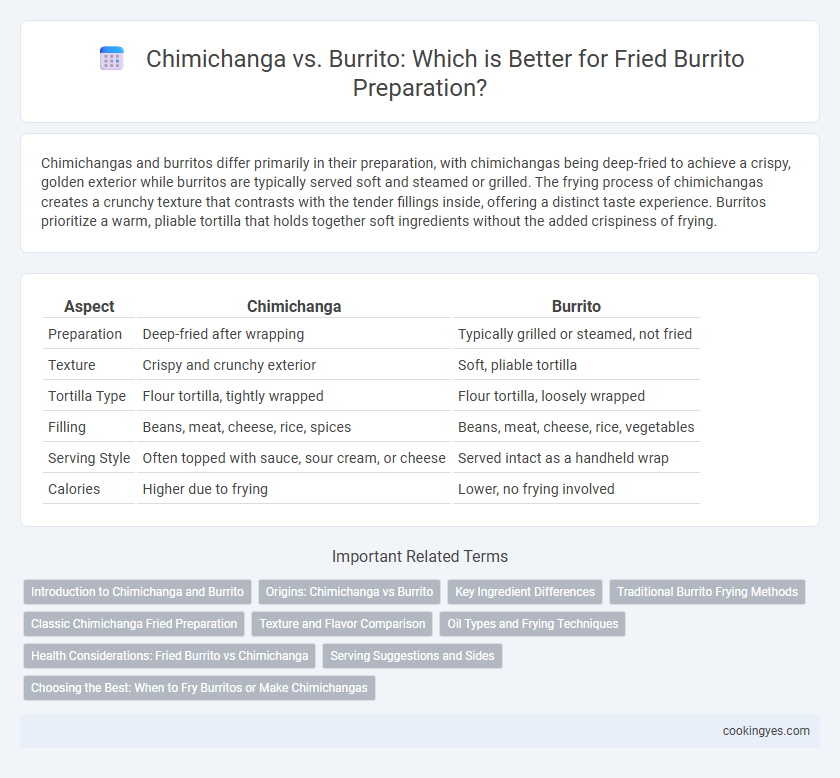Chimichangas and burritos differ primarily in their preparation, with chimichangas being deep-fried to achieve a crispy, golden exterior while burritos are typically served soft and steamed or grilled. The frying process of chimichangas creates a crunchy texture that contrasts with the tender fillings inside, offering a distinct taste experience. Burritos prioritize a warm, pliable tortilla that holds together soft ingredients without the added crispiness of frying.
Table of Comparison
| Aspect | Chimichanga | Burrito |
|---|---|---|
| Preparation | Deep-fried after wrapping | Typically grilled or steamed, not fried |
| Texture | Crispy and crunchy exterior | Soft, pliable tortilla |
| Tortilla Type | Flour tortilla, tightly wrapped | Flour tortilla, loosely wrapped |
| Filling | Beans, meat, cheese, rice, spices | Beans, meat, cheese, rice, vegetables |
| Serving Style | Often topped with sauce, sour cream, or cheese | Served intact as a handheld wrap |
| Calories | Higher due to frying | Lower, no frying involved |
Introduction to Chimichanga and Burrito
Chimichanga and burrito are both classic Mexican-inspired dishes, but their key difference lies in the cooking method: chimichangas are deep-fried burritos, resulting in a crispy, golden exterior, while burritos are traditionally served soft and steamed or grilled. Burritos typically feature a flour tortilla filled with ingredients such as rice, beans, meat, cheese, and vegetables, wrapped tightly, maintaining a tender texture. The frying process of chimichangas adds a distinct crunch and richer flavor profile, making them a popular choice for those seeking a crispy variation of the traditional burrito.
Origins: Chimichanga vs Burrito
Chimichangas originate from the American Southwest, specifically Arizona, and are believed to be a deep-fried variation of the traditional Mexican burrito, which hails from northern Mexico. Burritos consist of a flour tortilla filled with ingredients like meat, beans, and cheese, usually served without frying, while chimichangas are purposely deep-fried to create a crispy exterior. This difference in preparation reflects the fusion of Mexican culinary tradition with American regional tastes, giving rise to the chimichanga's distinctive texture and flavor profile.
Key Ingredient Differences
Chimichangas are deep-fried burritos, distinguished by their crispy exterior achieved through frying, while traditional burritos are typically served soft and steamed or grilled. The key ingredient difference lies in the tortilla's preparation: chimichangas use flour tortillas that can withstand frying without falling apart, and often include fillings like shredded meat, beans, and cheese that blend well when fried. Burritos frequently incorporate fresh vegetables, rice, and salsa, emphasizing a softer texture and distinct layering of flavors.
Traditional Burrito Frying Methods
Traditional burrito frying methods emphasize a quick, shallow fry where the wrapped tortilla is crisped without overly saturating the filling, preserving its texture and flavor. Unlike chimichangas, which undergo deep frying resulting in a fully crispy and crunchy exterior, burritos are typically pan-fried or griddled to maintain a balanced softness and crunch. This technique highlights the burrito's blend of tender fillings while adding a subtle, golden crispness to the tortilla.
Classic Chimichanga Fried Preparation
Classic chimichanga fried preparation involves deep-frying a burrito filled with ingredients like shredded meat, cheese, and beans, resulting in a crispy, golden exterior. Unlike a traditional burrito that is typically served soft and warm, the chimichanga's fried shell creates a crunchy texture contrast with its savory filling. This frying technique intensifies flavors and adds a distinct crispiness that differentiates a chimichanga from a standard burrito.
Texture and Flavor Comparison
Chimichangas feature a deep-fried tortilla that creates a crispy, crunchy outer texture, contrasting with the soft, pliable tortilla of a traditional burrito. The frying process intensifies the flavor by adding a rich, savory crispness and caramelized notes, while burritos maintain a fresh and mild taste profile. Both dishes offer a satisfying taste experience, but chimichangas deliver a more robust crunch and enhanced depth of flavor due to frying.
Oil Types and Frying Techniques
Chimichangas are deep-fried using high smoke point oils such as vegetable, canola, or peanut oil to achieve a crispy outer texture without burning. Burritos are typically not fried, but when pan-fried, they use a small amount of oil like olive or vegetable oil for a lighter, less greasy finish. Deep frying chimichangas involves submerging the tortilla fully in hot oil at around 350degF (175degC), whereas burritos are lightly seared on a skillet to warm the filling and crisp the tortilla surface.
Health Considerations: Fried Burrito vs Chimichanga
Chimichangas are deep-fried burritos, resulting in a higher calorie and fat content compared to non-fried burritos, which impacts heart health and weight management. Fried preparation increases the risk of consuming trans fats and oxidized oils, potentially leading to elevated cholesterol levels. Choosing a baked or grilled burrito offers a healthier alternative while maintaining flavor and texture.
Serving Suggestions and Sides
A chimichanga is a deep-fried burrito, offering a crispy exterior that pairs well with creamy guacamole, tangy salsa, and cooling sour cream to balance its richness. Burritos, typically steamed or grilled, are often served with fresh pico de gallo, refried beans, and Mexican rice, emphasizing softer textures and vibrant flavors. Both dishes complement crisp tortilla chips and zesty jalapenos, enhancing their bold, savory profiles.
Choosing the Best: When to Fry Burritos or Make Chimichangas
Frying burritos is ideal when you want a crispy exterior while retaining a soft interior, often achieved by using smaller, tightly wrapped burritos with less filling to prevent bursting. Chimichangas are specifically designed for frying, typically larger with robust fillings and a thicker tortilla, ensuring they hold up well and develop a golden, crunchy texture. Choose fried burritos for a lighter crunch and chimichangas when craving a rich, crispy dish with deep flavors enhanced by the frying process.
Chimichanga vs burrito for fried preparation Infographic

 cookingyes.com
cookingyes.com